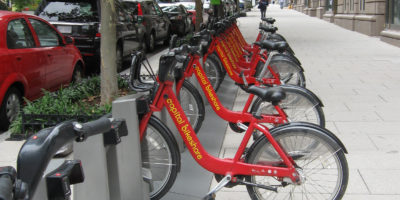Thank you to guest blogger Steve Yaffe for writing this month’s blog about newer transportation options that have become popular over the past five years and how barriers can be addressed so that options can be more accessible for older adults and travelers with disabilities.
New Mobility Services have three major accessibility barriers. These barriers can be surmounted. Public entities developing partnerships with new mobility services share the responsibility for surmounting these accessibility barriers by setting expectations and facilitating solutions.

#1: Most app-based vehicles are physically inaccessible to those using wheelchairs or scooters.
Potential Solutions:
- Uber & Lyft are attempting to address this by partnering with MV & First Transit, respectively. Both MV and First Transit have expertise in procuring, operating and maintaining accessible vehicles and transporting people with disabilities. This solution is being pioneered in a few large cities where these firms already have an operating/maintenance facility.
- Several companies designing automated vehicles are now including accessibility features. This is relevant, as both Uber and Lyft have expressed intent to transition at least partially to fully-automated vehicles.
- Many taxi companies have included accessible vehicles in their fleets. Medical Transportation Companies also use accessible vehicles. To be sustainable, payments for rides provided and for maintaining this capacity must cover the additional cost for vehicle purchase, maintenance and driver training. Taxis can’t charge more to wheelchair-users, so a substantial proportion of wheelchair rides require subsidies to cover the additional costs.
- Chicago has developed a shared dispatch system to distribute requests for accessible taxi rides among participating companies – http://www.opentaxis.com. Washington DC has a shared dispatch system for accessible and sedan taxis – https://dctaxionline.com. The advantage of a shared dispatch system is reduced wait time for riders.
Key Performance Indicators:
- Are the average wait times between trip request and pickup for ambulatory and non-ambulatory passengers similar? Having an average wait time of seven minutes for an ambulatory passenger vs. 90 minutes for a wheelchair-user is not a similar level of service.
- Is the vehicle actually usable by people with disabilities without having to duck (lack of headroom) or transfer to a seat? Federal Transit Administration accessibility specifications were developed with that intent.
#2: App-based services are account based – one can’t pay the driver with cash.
Yet “16 million adults–or 7 percent of the overall adult population–are unbanked, meaning they do not have a checking, savings, or money market account”. One out of seven adults (14.7%) with less than $40,000 household income do not have a credit card, as they are unbanked. Source: Report on the Economic Well-Being of U.S. Households in 2016 – May 2017.
Potential Solution:
An electronic balance transfer (EBT) Mobility Card, accepting cash & subsidy uploads. EBT cards are already used by nutrition programs such as WIC and SNAP. A small but growing number of transit systems already offer account-based fare payment systems (such as Chicago’s Ventra card) that can be used on bikeshare and other modes. Riders can add cash to those accounts on-line and at kiosks or outlets. Government programs subsidizing rides to designated individuals for designated purposes on designated providers could instead add funds to individual EBT Mobility Cards, allowing the user to choose their ride providers (including transit). This would incent ride providers to be accessible and efficiently schedule and group rides by geography as transit does, instead of segregating riders by their funding stream.
Key Performance Indicators:
- Boardings per Vehicle Service Hour is a standard indicator of efficiency in demand response transportation. Boardings per Vehicle Service Mile is sometimes substituted, particularly in rural areas.
- Rides provided per $100,000 of subsidy is an emerging indicator displaying the impact of ride subsidy programs.
- Comparing the proportion of riders by household income (and other demographic gradients) compared to the service area population indicates whether a program subsidized by a transit agency is successfully serving the community. A user survey would be required to gather the rider data.

#3: App-based services are tailored to the smartphone. We forget that Smartphone Market Penetration is not uniform for all demographic groups, as shown by data from PewResearch.org.
| Demographic Group | Smartphone Market Penetration | |
| General Public | 81% | |
| Annual Household Income Below $30,000 | 71% | |
| People with Disabilities | General | 58% |
| Younger Adults | 70% | |
| Adults 65 and Older | 32% | |
| Rural Residents | 71% | |
Potential Solutions:
- Some riders can book through a call center, depending on the mobility provider and the subsidy program. Some of these partnerships also supply a cell phone.
- Some medical offices are able to book rides through a portal for riders and mobility providers who have provided permission and access.
- Training in the use of new mobility programs – as well as transit travel-training – sets expectations and benefits both riders and ride providers. Several new mobility providers provide instruction on how to use their app via YouTube. A growing number of local transit providers as well as local centers for independent living provide transit travel-training assistance without a fee.
Key Performance Indicator:
- Comparing the proportion of riders by key demographic gradients compared to the service area population indicates whether a program subsidized by a transit agency is successfully serving the community. A user survey would be required to gather the rider data.
Your comments to this blog are welcome! Please email the author at yaffe@YMobility.info or leave a comment below.
Steve Yaffe is an independent consultant and a contractor for the National Aging and Disability Transportation Center. He draws upon 40 years’ experience planning, procuring, overseeing and evaluating demand response and fixed route transit services, including 16 years with a consolidated human service transportation program. He has served on research panels and co-chaired the 2019 Transportation Research Board’s International Conference on Demand Responsive and Innovative Transportation Services.
Leave a Reply